Analysis of IKEA's Business Environment and Organizational Functions
VerifiedAdded on 2020/07/22
|11
|3334
|108
Report
AI Summary
This report provides a comprehensive analysis of IKEA's business environment, focusing on its internal and external factors. It explores the relationship between various organizational functions, such as marketing, finance, and human resources, and their contribution to achieving business objectives. The report examines the positive and negative impacts of the macro environment on IKEA, including legal, technological, economic, and political factors. Furthermore, it conducts an internal and external analysis of IKEA, identifying its strengths, weaknesses, opportunities, and threats. The analysis also highlights the interconnection of different business functions and their impact on IKEA's success, considering various organizational structures like functional, divisional, and matrix structures. The report concludes by summarizing key findings and providing insights into IKEA's strategic approach to navigate the competitive business landscape.
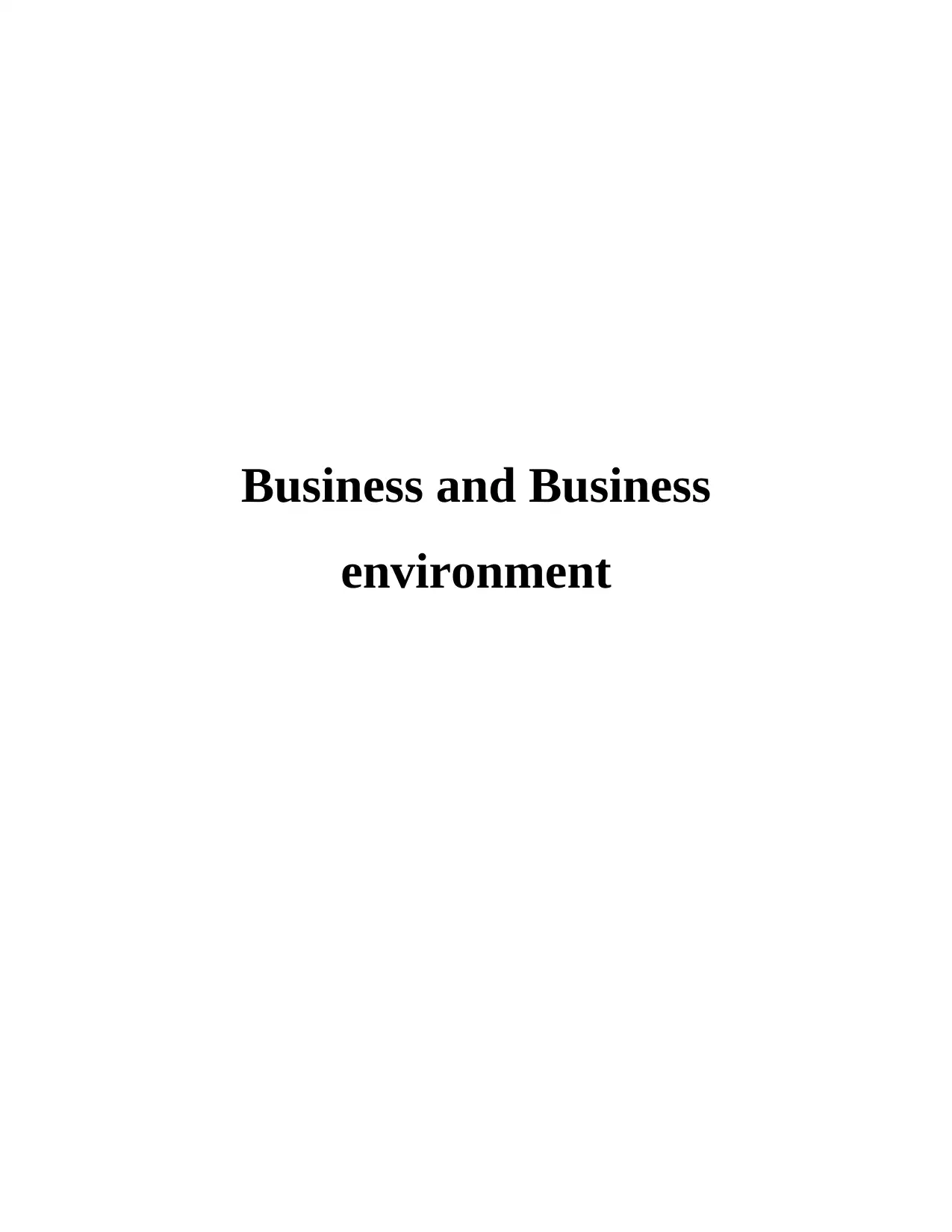
Business and Business
environment
environment
Paraphrase This Document
Need a fresh take? Get an instant paraphrase of this document with our AI Paraphraser
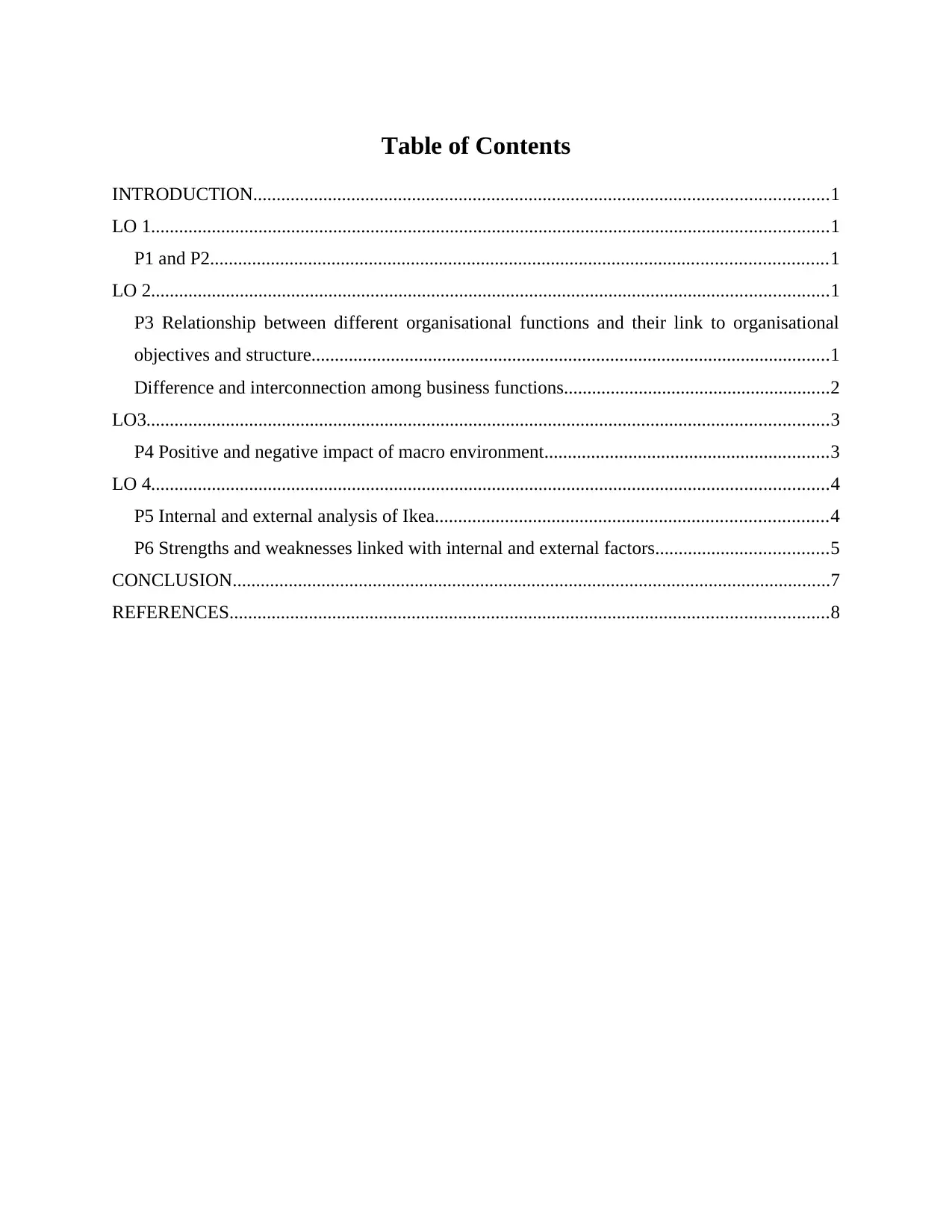
Table of Contents
INTRODUCTION...........................................................................................................................1
LO 1.................................................................................................................................................1
P1 and P2....................................................................................................................................1
LO 2.................................................................................................................................................1
P3 Relationship between different organisational functions and their link to organisational
objectives and structure...............................................................................................................1
Difference and interconnection among business functions.........................................................2
LO3..................................................................................................................................................3
P4 Positive and negative impact of macro environment.............................................................3
LO 4.................................................................................................................................................4
P5 Internal and external analysis of Ikea....................................................................................4
P6 Strengths and weaknesses linked with internal and external factors.....................................5
CONCLUSION................................................................................................................................7
REFERENCES................................................................................................................................8
INTRODUCTION...........................................................................................................................1
LO 1.................................................................................................................................................1
P1 and P2....................................................................................................................................1
LO 2.................................................................................................................................................1
P3 Relationship between different organisational functions and their link to organisational
objectives and structure...............................................................................................................1
Difference and interconnection among business functions.........................................................2
LO3..................................................................................................................................................3
P4 Positive and negative impact of macro environment.............................................................3
LO 4.................................................................................................................................................4
P5 Internal and external analysis of Ikea....................................................................................4
P6 Strengths and weaknesses linked with internal and external factors.....................................5
CONCLUSION................................................................................................................................7
REFERENCES................................................................................................................................8
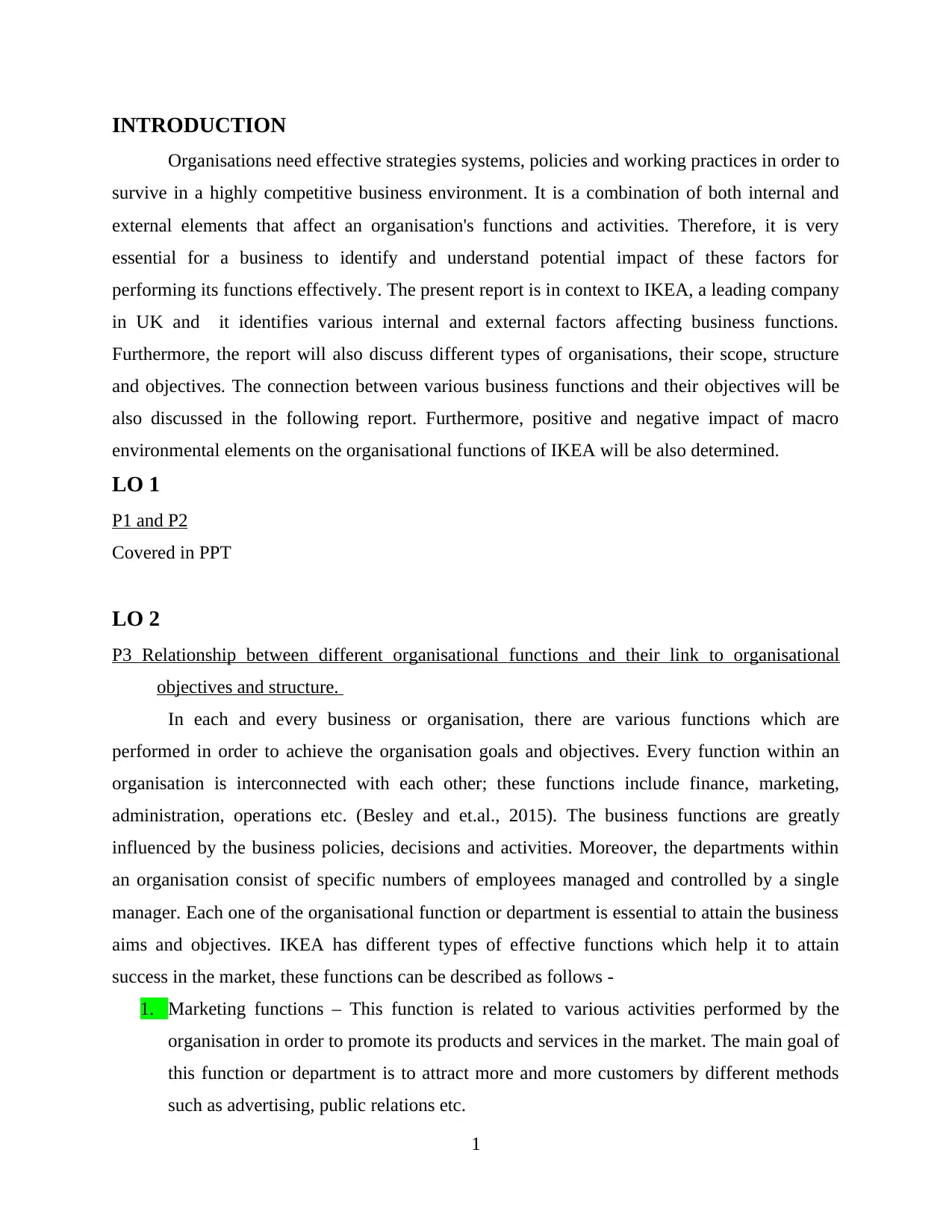
INTRODUCTION
Organisations need effective strategies systems, policies and working practices in order to
survive in a highly competitive business environment. It is a combination of both internal and
external elements that affect an organisation's functions and activities. Therefore, it is very
essential for a business to identify and understand potential impact of these factors for
performing its functions effectively. The present report is in context to IKEA, a leading company
in UK and it identifies various internal and external factors affecting business functions.
Furthermore, the report will also discuss different types of organisations, their scope, structure
and objectives. The connection between various business functions and their objectives will be
also discussed in the following report. Furthermore, positive and negative impact of macro
environmental elements on the organisational functions of IKEA will be also determined.
LO 1
P1 and P2
Covered in PPT
LO 2
P3 Relationship between different organisational functions and their link to organisational
objectives and structure.
In each and every business or organisation, there are various functions which are
performed in order to achieve the organisation goals and objectives. Every function within an
organisation is interconnected with each other; these functions include finance, marketing,
administration, operations etc. (Besley and et.al., 2015). The business functions are greatly
influenced by the business policies, decisions and activities. Moreover, the departments within
an organisation consist of specific numbers of employees managed and controlled by a single
manager. Each one of the organisational function or department is essential to attain the business
aims and objectives. IKEA has different types of effective functions which help it to attain
success in the market, these functions can be described as follows -
1. Marketing functions – This function is related to various activities performed by the
organisation in order to promote its products and services in the market. The main goal of
this function or department is to attract more and more customers by different methods
such as advertising, public relations etc.
1
Organisations need effective strategies systems, policies and working practices in order to
survive in a highly competitive business environment. It is a combination of both internal and
external elements that affect an organisation's functions and activities. Therefore, it is very
essential for a business to identify and understand potential impact of these factors for
performing its functions effectively. The present report is in context to IKEA, a leading company
in UK and it identifies various internal and external factors affecting business functions.
Furthermore, the report will also discuss different types of organisations, their scope, structure
and objectives. The connection between various business functions and their objectives will be
also discussed in the following report. Furthermore, positive and negative impact of macro
environmental elements on the organisational functions of IKEA will be also determined.
LO 1
P1 and P2
Covered in PPT
LO 2
P3 Relationship between different organisational functions and their link to organisational
objectives and structure.
In each and every business or organisation, there are various functions which are
performed in order to achieve the organisation goals and objectives. Every function within an
organisation is interconnected with each other; these functions include finance, marketing,
administration, operations etc. (Besley and et.al., 2015). The business functions are greatly
influenced by the business policies, decisions and activities. Moreover, the departments within
an organisation consist of specific numbers of employees managed and controlled by a single
manager. Each one of the organisational function or department is essential to attain the business
aims and objectives. IKEA has different types of effective functions which help it to attain
success in the market, these functions can be described as follows -
1. Marketing functions – This function is related to various activities performed by the
organisation in order to promote its products and services in the market. The main goal of
this function or department is to attract more and more customers by different methods
such as advertising, public relations etc.
1
⊘ This is a preview!⊘
Do you want full access?
Subscribe today to unlock all pages.

Trusted by 1+ million students worldwide
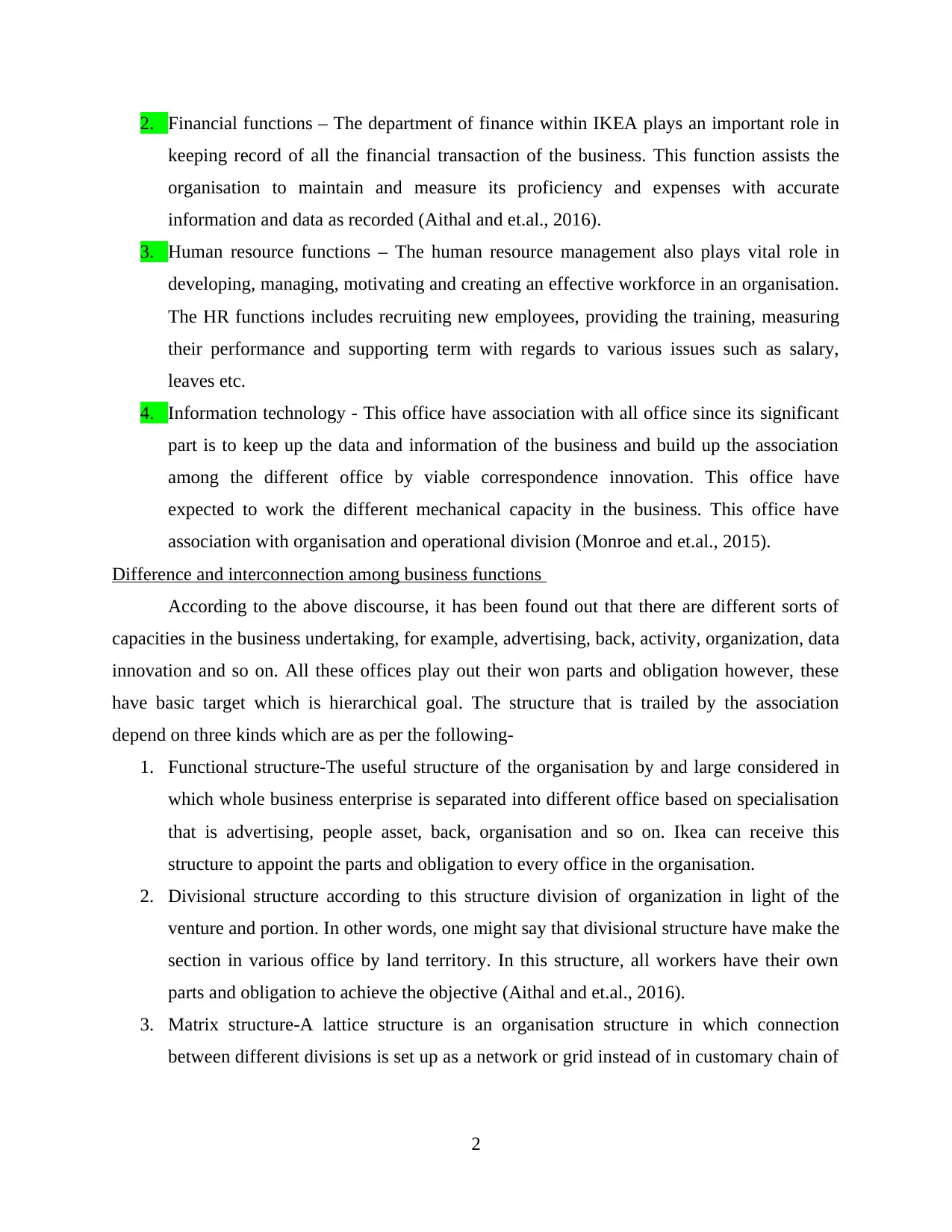
2. Financial functions – The department of finance within IKEA plays an important role in
keeping record of all the financial transaction of the business. This function assists the
organisation to maintain and measure its proficiency and expenses with accurate
information and data as recorded (Aithal and et.al., 2016).
3. Human resource functions – The human resource management also plays vital role in
developing, managing, motivating and creating an effective workforce in an organisation.
The HR functions includes recruiting new employees, providing the training, measuring
their performance and supporting term with regards to various issues such as salary,
leaves etc.
4. Information technology - This office have association with all office since its significant
part is to keep up the data and information of the business and build up the association
among the different office by viable correspondence innovation. This office have
expected to work the different mechanical capacity in the business. This office have
association with organisation and operational division (Monroe and et.al., 2015).
Difference and interconnection among business functions
According to the above discourse, it has been found out that there are different sorts of
capacities in the business undertaking, for example, advertising, back, activity, organization, data
innovation and so on. All these offices play out their won parts and obligation however, these
have basic target which is hierarchical goal. The structure that is trailed by the association
depend on three kinds which are as per the following-
1. Functional structure-The useful structure of the organisation by and large considered in
which whole business enterprise is separated into different office based on specialisation
that is advertising, people asset, back, organisation and so on. Ikea can receive this
structure to appoint the parts and obligation to every office in the organisation.
2. Divisional structure according to this structure division of organization in light of the
venture and portion. In other words, one might say that divisional structure have make the
section in various office by land territory. In this structure, all workers have their own
parts and obligation to achieve the objective (Aithal and et.al., 2016).
3. Matrix structure-A lattice structure is an organisation structure in which connection
between different divisions is set up as a network or grid instead of in customary chain of
2
keeping record of all the financial transaction of the business. This function assists the
organisation to maintain and measure its proficiency and expenses with accurate
information and data as recorded (Aithal and et.al., 2016).
3. Human resource functions – The human resource management also plays vital role in
developing, managing, motivating and creating an effective workforce in an organisation.
The HR functions includes recruiting new employees, providing the training, measuring
their performance and supporting term with regards to various issues such as salary,
leaves etc.
4. Information technology - This office have association with all office since its significant
part is to keep up the data and information of the business and build up the association
among the different office by viable correspondence innovation. This office have
expected to work the different mechanical capacity in the business. This office have
association with organisation and operational division (Monroe and et.al., 2015).
Difference and interconnection among business functions
According to the above discourse, it has been found out that there are different sorts of
capacities in the business undertaking, for example, advertising, back, activity, organization, data
innovation and so on. All these offices play out their won parts and obligation however, these
have basic target which is hierarchical goal. The structure that is trailed by the association
depend on three kinds which are as per the following-
1. Functional structure-The useful structure of the organisation by and large considered in
which whole business enterprise is separated into different office based on specialisation
that is advertising, people asset, back, organisation and so on. Ikea can receive this
structure to appoint the parts and obligation to every office in the organisation.
2. Divisional structure according to this structure division of organization in light of the
venture and portion. In other words, one might say that divisional structure have make the
section in various office by land territory. In this structure, all workers have their own
parts and obligation to achieve the objective (Aithal and et.al., 2016).
3. Matrix structure-A lattice structure is an organisation structure in which connection
between different divisions is set up as a network or grid instead of in customary chain of
2
Paraphrase This Document
Need a fresh take? Get an instant paraphrase of this document with our AI Paraphraser
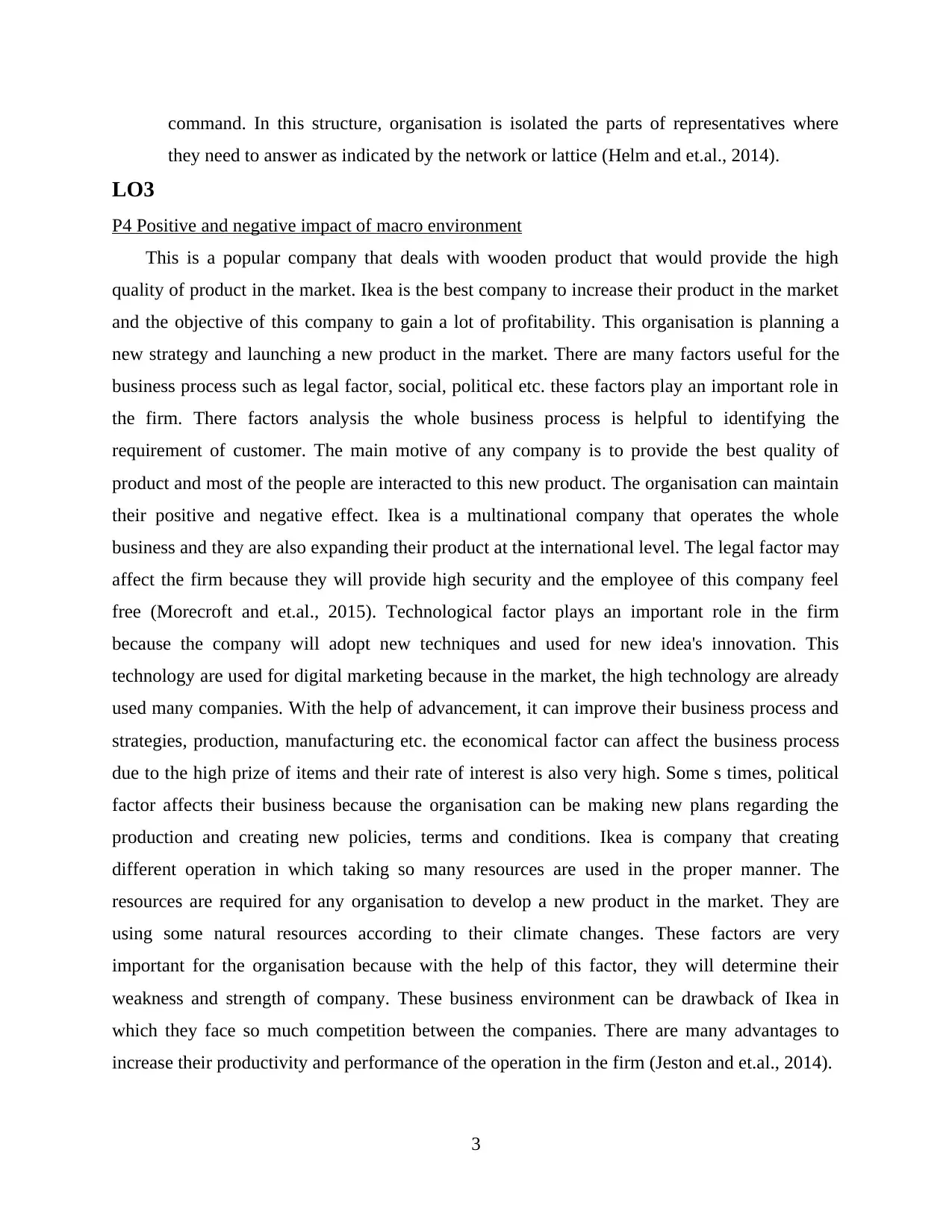
command. In this structure, organisation is isolated the parts of representatives where
they need to answer as indicated by the network or lattice (Helm and et.al., 2014).
LO3
P4 Positive and negative impact of macro environment
This is a popular company that deals with wooden product that would provide the high
quality of product in the market. Ikea is the best company to increase their product in the market
and the objective of this company to gain a lot of profitability. This organisation is planning a
new strategy and launching a new product in the market. There are many factors useful for the
business process such as legal factor, social, political etc. these factors play an important role in
the firm. There factors analysis the whole business process is helpful to identifying the
requirement of customer. The main motive of any company is to provide the best quality of
product and most of the people are interacted to this new product. The organisation can maintain
their positive and negative effect. Ikea is a multinational company that operates the whole
business and they are also expanding their product at the international level. The legal factor may
affect the firm because they will provide high security and the employee of this company feel
free (Morecroft and et.al., 2015). Technological factor plays an important role in the firm
because the company will adopt new techniques and used for new idea's innovation. This
technology are used for digital marketing because in the market, the high technology are already
used many companies. With the help of advancement, it can improve their business process and
strategies, production, manufacturing etc. the economical factor can affect the business process
due to the high prize of items and their rate of interest is also very high. Some s times, political
factor affects their business because the organisation can be making new plans regarding the
production and creating new policies, terms and conditions. Ikea is company that creating
different operation in which taking so many resources are used in the proper manner. The
resources are required for any organisation to develop a new product in the market. They are
using some natural resources according to their climate changes. These factors are very
important for the organisation because with the help of this factor, they will determine their
weakness and strength of company. These business environment can be drawback of Ikea in
which they face so much competition between the companies. There are many advantages to
increase their productivity and performance of the operation in the firm (Jeston and et.al., 2014).
3
they need to answer as indicated by the network or lattice (Helm and et.al., 2014).
LO3
P4 Positive and negative impact of macro environment
This is a popular company that deals with wooden product that would provide the high
quality of product in the market. Ikea is the best company to increase their product in the market
and the objective of this company to gain a lot of profitability. This organisation is planning a
new strategy and launching a new product in the market. There are many factors useful for the
business process such as legal factor, social, political etc. these factors play an important role in
the firm. There factors analysis the whole business process is helpful to identifying the
requirement of customer. The main motive of any company is to provide the best quality of
product and most of the people are interacted to this new product. The organisation can maintain
their positive and negative effect. Ikea is a multinational company that operates the whole
business and they are also expanding their product at the international level. The legal factor may
affect the firm because they will provide high security and the employee of this company feel
free (Morecroft and et.al., 2015). Technological factor plays an important role in the firm
because the company will adopt new techniques and used for new idea's innovation. This
technology are used for digital marketing because in the market, the high technology are already
used many companies. With the help of advancement, it can improve their business process and
strategies, production, manufacturing etc. the economical factor can affect the business process
due to the high prize of items and their rate of interest is also very high. Some s times, political
factor affects their business because the organisation can be making new plans regarding the
production and creating new policies, terms and conditions. Ikea is company that creating
different operation in which taking so many resources are used in the proper manner. The
resources are required for any organisation to develop a new product in the market. They are
using some natural resources according to their climate changes. These factors are very
important for the organisation because with the help of this factor, they will determine their
weakness and strength of company. These business environment can be drawback of Ikea in
which they face so much competition between the companies. There are many advantages to
increase their productivity and performance of the operation in the firm (Jeston and et.al., 2014).
3
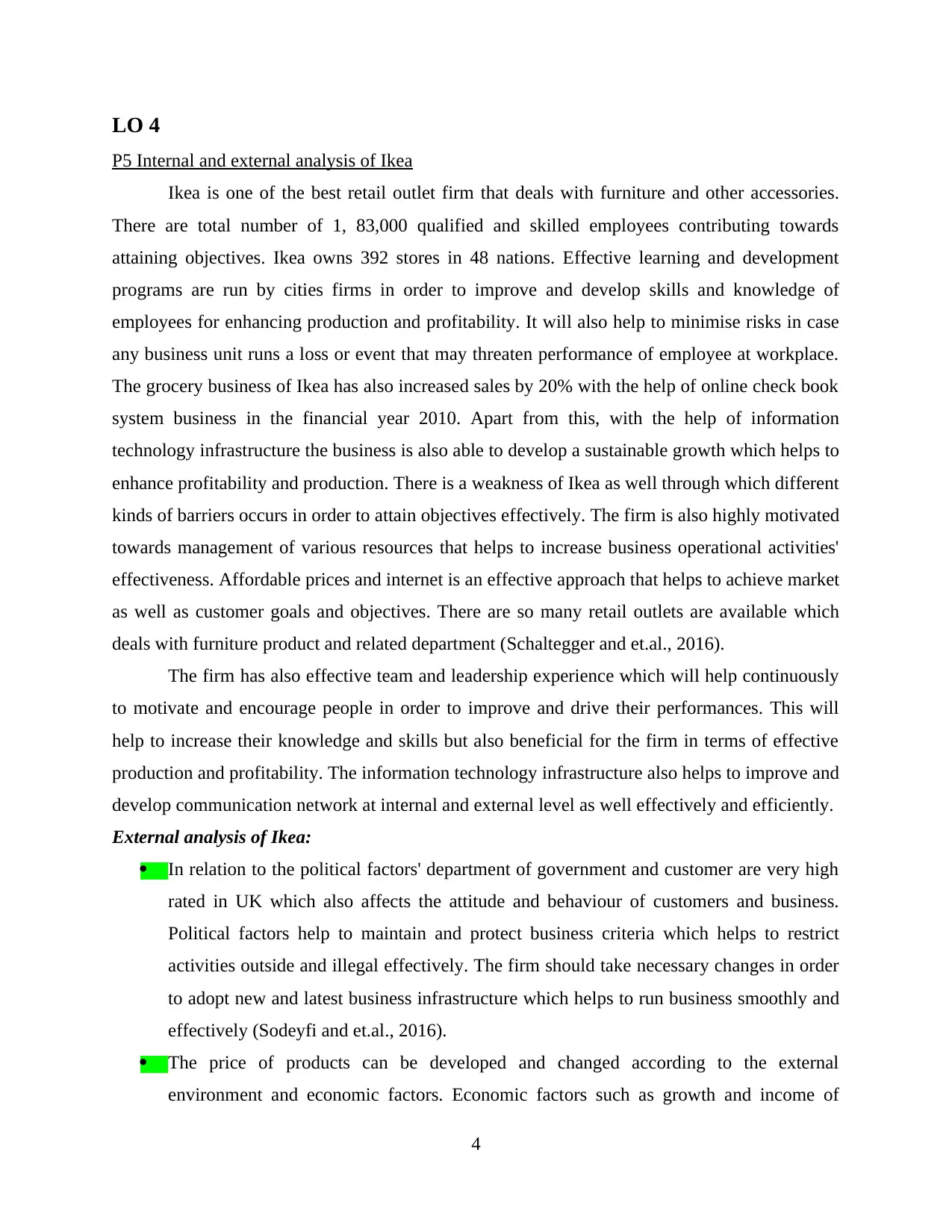
LO 4
P5 Internal and external analysis of Ikea
Ikea is one of the best retail outlet firm that deals with furniture and other accessories.
There are total number of 1, 83,000 qualified and skilled employees contributing towards
attaining objectives. Ikea owns 392 stores in 48 nations. Effective learning and development
programs are run by cities firms in order to improve and develop skills and knowledge of
employees for enhancing production and profitability. It will also help to minimise risks in case
any business unit runs a loss or event that may threaten performance of employee at workplace.
The grocery business of Ikea has also increased sales by 20% with the help of online check book
system business in the financial year 2010. Apart from this, with the help of information
technology infrastructure the business is also able to develop a sustainable growth which helps to
enhance profitability and production. There is a weakness of Ikea as well through which different
kinds of barriers occurs in order to attain objectives effectively. The firm is also highly motivated
towards management of various resources that helps to increase business operational activities'
effectiveness. Affordable prices and internet is an effective approach that helps to achieve market
as well as customer goals and objectives. There are so many retail outlets are available which
deals with furniture product and related department (Schaltegger and et.al., 2016).
The firm has also effective team and leadership experience which will help continuously
to motivate and encourage people in order to improve and drive their performances. This will
help to increase their knowledge and skills but also beneficial for the firm in terms of effective
production and profitability. The information technology infrastructure also helps to improve and
develop communication network at internal and external level as well effectively and efficiently.
External analysis of Ikea:
In relation to the political factors' department of government and customer are very high
rated in UK which also affects the attitude and behaviour of customers and business.
Political factors help to maintain and protect business criteria which helps to restrict
activities outside and illegal effectively. The firm should take necessary changes in order
to adopt new and latest business infrastructure which helps to run business smoothly and
effectively (Sodeyfi and et.al., 2016).
The price of products can be developed and changed according to the external
environment and economic factors. Economic factors such as growth and income of
4
P5 Internal and external analysis of Ikea
Ikea is one of the best retail outlet firm that deals with furniture and other accessories.
There are total number of 1, 83,000 qualified and skilled employees contributing towards
attaining objectives. Ikea owns 392 stores in 48 nations. Effective learning and development
programs are run by cities firms in order to improve and develop skills and knowledge of
employees for enhancing production and profitability. It will also help to minimise risks in case
any business unit runs a loss or event that may threaten performance of employee at workplace.
The grocery business of Ikea has also increased sales by 20% with the help of online check book
system business in the financial year 2010. Apart from this, with the help of information
technology infrastructure the business is also able to develop a sustainable growth which helps to
enhance profitability and production. There is a weakness of Ikea as well through which different
kinds of barriers occurs in order to attain objectives effectively. The firm is also highly motivated
towards management of various resources that helps to increase business operational activities'
effectiveness. Affordable prices and internet is an effective approach that helps to achieve market
as well as customer goals and objectives. There are so many retail outlets are available which
deals with furniture product and related department (Schaltegger and et.al., 2016).
The firm has also effective team and leadership experience which will help continuously
to motivate and encourage people in order to improve and drive their performances. This will
help to increase their knowledge and skills but also beneficial for the firm in terms of effective
production and profitability. The information technology infrastructure also helps to improve and
develop communication network at internal and external level as well effectively and efficiently.
External analysis of Ikea:
In relation to the political factors' department of government and customer are very high
rated in UK which also affects the attitude and behaviour of customers and business.
Political factors help to maintain and protect business criteria which helps to restrict
activities outside and illegal effectively. The firm should take necessary changes in order
to adopt new and latest business infrastructure which helps to run business smoothly and
effectively (Sodeyfi and et.al., 2016).
The price of products can be developed and changed according to the external
environment and economic factors. Economic factors such as growth and income of
4
⊘ This is a preview!⊘
Do you want full access?
Subscribe today to unlock all pages.

Trusted by 1+ million students worldwide
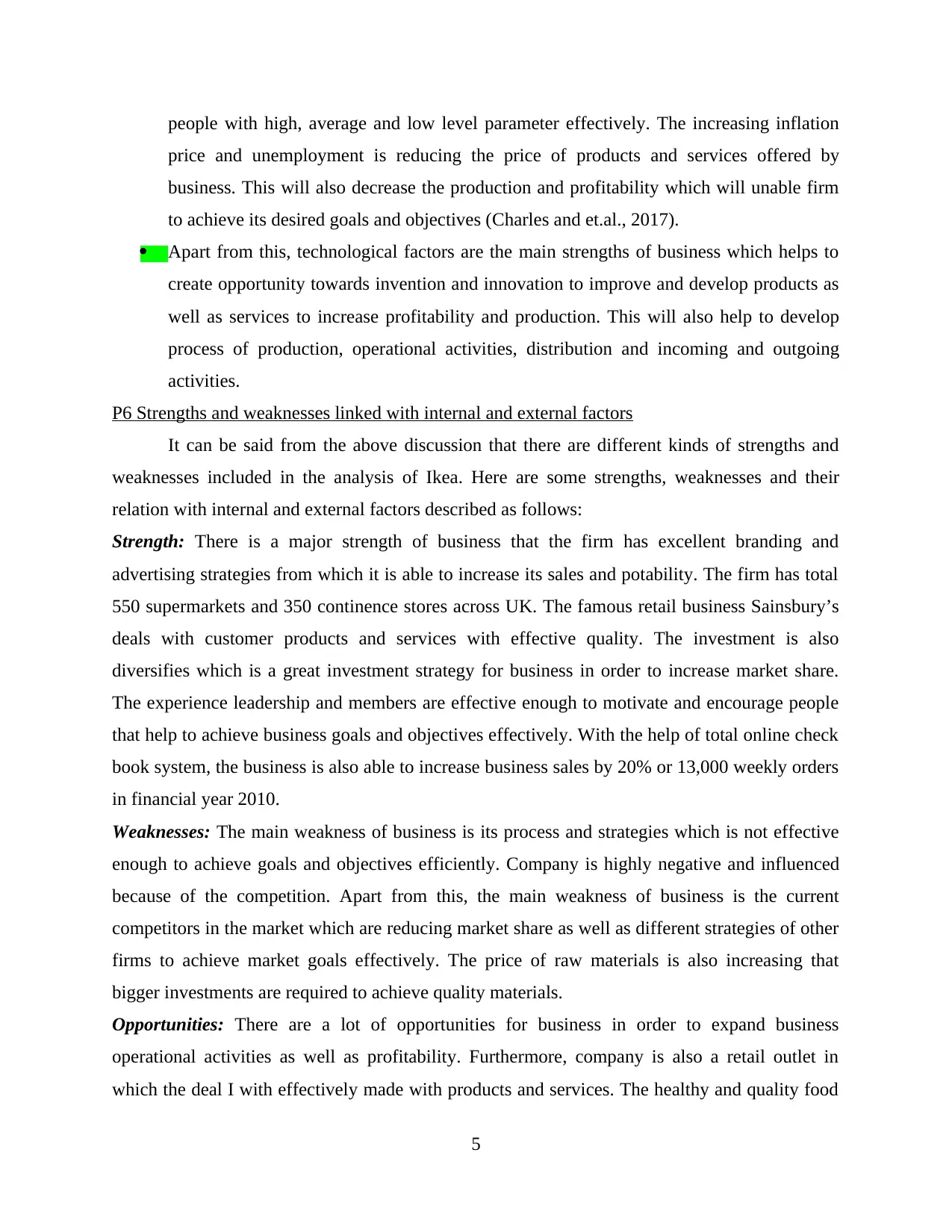
people with high, average and low level parameter effectively. The increasing inflation
price and unemployment is reducing the price of products and services offered by
business. This will also decrease the production and profitability which will unable firm
to achieve its desired goals and objectives (Charles and et.al., 2017).
Apart from this, technological factors are the main strengths of business which helps to
create opportunity towards invention and innovation to improve and develop products as
well as services to increase profitability and production. This will also help to develop
process of production, operational activities, distribution and incoming and outgoing
activities.
P6 Strengths and weaknesses linked with internal and external factors
It can be said from the above discussion that there are different kinds of strengths and
weaknesses included in the analysis of Ikea. Here are some strengths, weaknesses and their
relation with internal and external factors described as follows:
Strength: There is a major strength of business that the firm has excellent branding and
advertising strategies from which it is able to increase its sales and potability. The firm has total
550 supermarkets and 350 continence stores across UK. The famous retail business Sainsbury’s
deals with customer products and services with effective quality. The investment is also
diversifies which is a great investment strategy for business in order to increase market share.
The experience leadership and members are effective enough to motivate and encourage people
that help to achieve business goals and objectives effectively. With the help of total online check
book system, the business is also able to increase business sales by 20% or 13,000 weekly orders
in financial year 2010.
Weaknesses: The main weakness of business is its process and strategies which is not effective
enough to achieve goals and objectives efficiently. Company is highly negative and influenced
because of the competition. Apart from this, the main weakness of business is the current
competitors in the market which are reducing market share as well as different strategies of other
firms to achieve market goals effectively. The price of raw materials is also increasing that
bigger investments are required to achieve quality materials.
Opportunities: There are a lot of opportunities for business in order to expand business
operational activities as well as profitability. Furthermore, company is also a retail outlet in
which the deal I with effectively made with products and services. The healthy and quality food
5
price and unemployment is reducing the price of products and services offered by
business. This will also decrease the production and profitability which will unable firm
to achieve its desired goals and objectives (Charles and et.al., 2017).
Apart from this, technological factors are the main strengths of business which helps to
create opportunity towards invention and innovation to improve and develop products as
well as services to increase profitability and production. This will also help to develop
process of production, operational activities, distribution and incoming and outgoing
activities.
P6 Strengths and weaknesses linked with internal and external factors
It can be said from the above discussion that there are different kinds of strengths and
weaknesses included in the analysis of Ikea. Here are some strengths, weaknesses and their
relation with internal and external factors described as follows:
Strength: There is a major strength of business that the firm has excellent branding and
advertising strategies from which it is able to increase its sales and potability. The firm has total
550 supermarkets and 350 continence stores across UK. The famous retail business Sainsbury’s
deals with customer products and services with effective quality. The investment is also
diversifies which is a great investment strategy for business in order to increase market share.
The experience leadership and members are effective enough to motivate and encourage people
that help to achieve business goals and objectives effectively. With the help of total online check
book system, the business is also able to increase business sales by 20% or 13,000 weekly orders
in financial year 2010.
Weaknesses: The main weakness of business is its process and strategies which is not effective
enough to achieve goals and objectives efficiently. Company is highly negative and influenced
because of the competition. Apart from this, the main weakness of business is the current
competitors in the market which are reducing market share as well as different strategies of other
firms to achieve market goals effectively. The price of raw materials is also increasing that
bigger investments are required to achieve quality materials.
Opportunities: There are a lot of opportunities for business in order to expand business
operational activities as well as profitability. Furthermore, company is also a retail outlet in
which the deal I with effectively made with products and services. The healthy and quality food
5
Paraphrase This Document
Need a fresh take? Get an instant paraphrase of this document with our AI Paraphraser
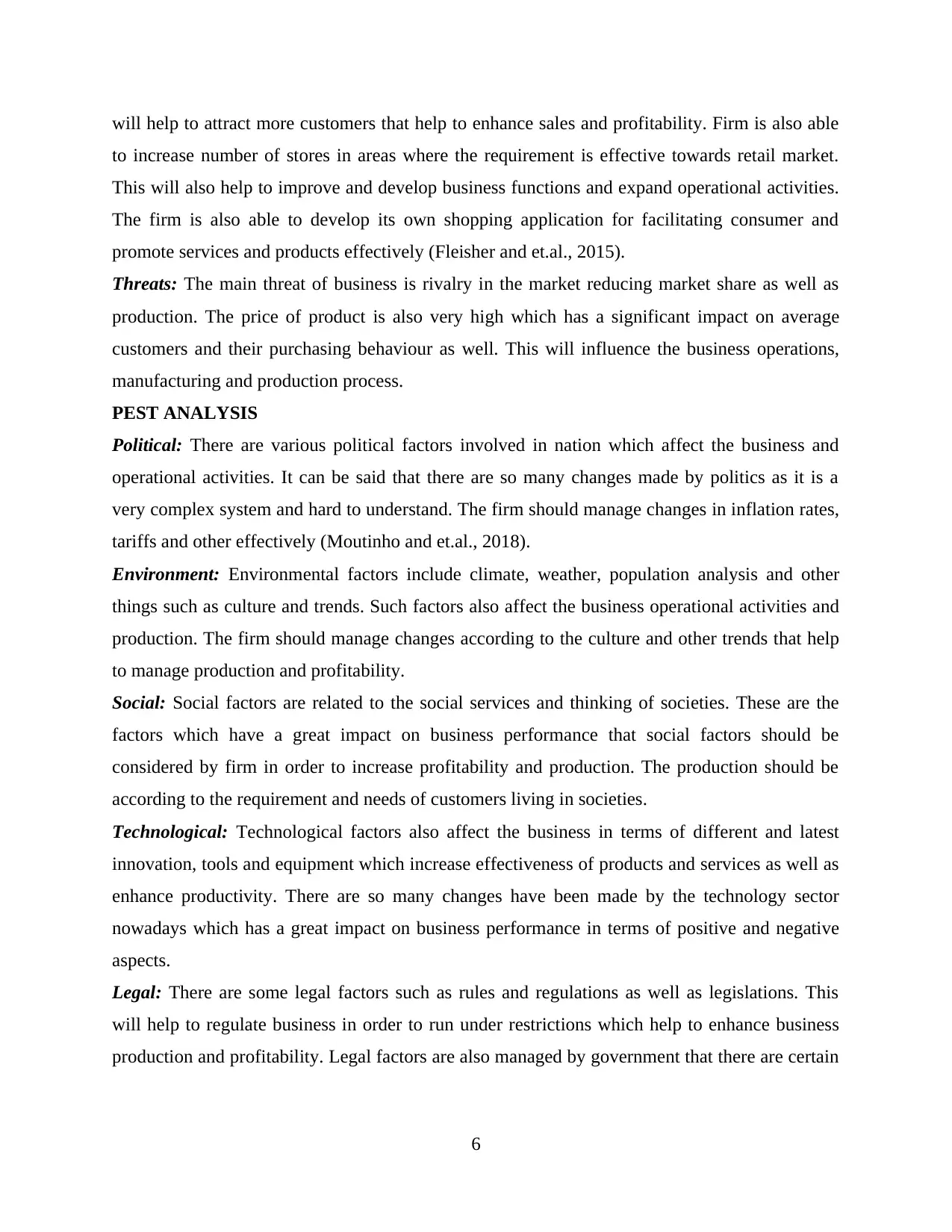
will help to attract more customers that help to enhance sales and profitability. Firm is also able
to increase number of stores in areas where the requirement is effective towards retail market.
This will also help to improve and develop business functions and expand operational activities.
The firm is also able to develop its own shopping application for facilitating consumer and
promote services and products effectively (Fleisher and et.al., 2015).
Threats: The main threat of business is rivalry in the market reducing market share as well as
production. The price of product is also very high which has a significant impact on average
customers and their purchasing behaviour as well. This will influence the business operations,
manufacturing and production process.
PEST ANALYSIS
Political: There are various political factors involved in nation which affect the business and
operational activities. It can be said that there are so many changes made by politics as it is a
very complex system and hard to understand. The firm should manage changes in inflation rates,
tariffs and other effectively (Moutinho and et.al., 2018).
Environment: Environmental factors include climate, weather, population analysis and other
things such as culture and trends. Such factors also affect the business operational activities and
production. The firm should manage changes according to the culture and other trends that help
to manage production and profitability.
Social: Social factors are related to the social services and thinking of societies. These are the
factors which have a great impact on business performance that social factors should be
considered by firm in order to increase profitability and production. The production should be
according to the requirement and needs of customers living in societies.
Technological: Technological factors also affect the business in terms of different and latest
innovation, tools and equipment which increase effectiveness of products and services as well as
enhance productivity. There are so many changes have been made by the technology sector
nowadays which has a great impact on business performance in terms of positive and negative
aspects.
Legal: There are some legal factors such as rules and regulations as well as legislations. This
will help to regulate business in order to run under restrictions which help to enhance business
production and profitability. Legal factors are also managed by government that there are certain
6
to increase number of stores in areas where the requirement is effective towards retail market.
This will also help to improve and develop business functions and expand operational activities.
The firm is also able to develop its own shopping application for facilitating consumer and
promote services and products effectively (Fleisher and et.al., 2015).
Threats: The main threat of business is rivalry in the market reducing market share as well as
production. The price of product is also very high which has a significant impact on average
customers and their purchasing behaviour as well. This will influence the business operations,
manufacturing and production process.
PEST ANALYSIS
Political: There are various political factors involved in nation which affect the business and
operational activities. It can be said that there are so many changes made by politics as it is a
very complex system and hard to understand. The firm should manage changes in inflation rates,
tariffs and other effectively (Moutinho and et.al., 2018).
Environment: Environmental factors include climate, weather, population analysis and other
things such as culture and trends. Such factors also affect the business operational activities and
production. The firm should manage changes according to the culture and other trends that help
to manage production and profitability.
Social: Social factors are related to the social services and thinking of societies. These are the
factors which have a great impact on business performance that social factors should be
considered by firm in order to increase profitability and production. The production should be
according to the requirement and needs of customers living in societies.
Technological: Technological factors also affect the business in terms of different and latest
innovation, tools and equipment which increase effectiveness of products and services as well as
enhance productivity. There are so many changes have been made by the technology sector
nowadays which has a great impact on business performance in terms of positive and negative
aspects.
Legal: There are some legal factors such as rules and regulations as well as legislations. This
will help to regulate business in order to run under restrictions which help to enhance business
production and profitability. Legal factors are also managed by government that there are certain
6
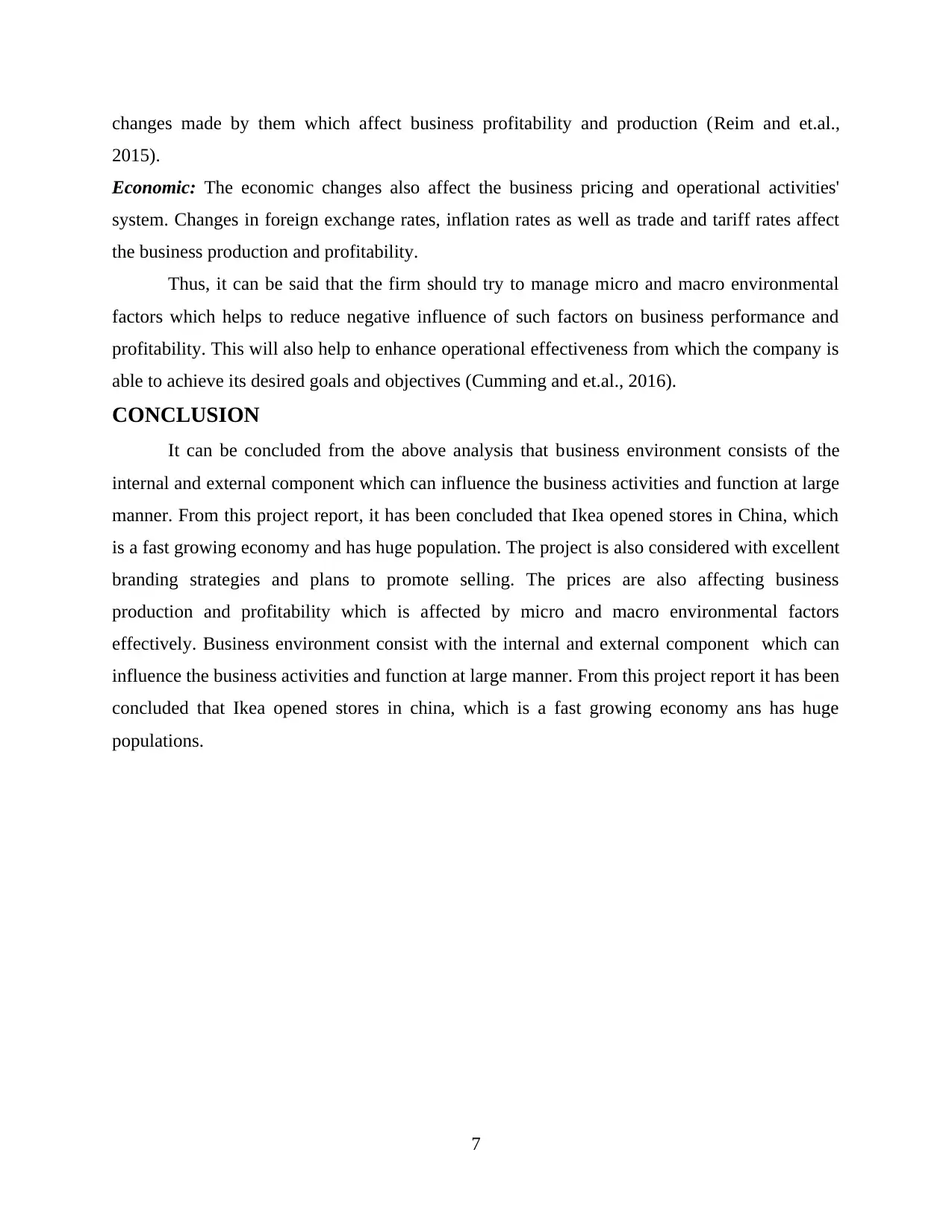
changes made by them which affect business profitability and production (Reim and et.al.,
2015).
Economic: The economic changes also affect the business pricing and operational activities'
system. Changes in foreign exchange rates, inflation rates as well as trade and tariff rates affect
the business production and profitability.
Thus, it can be said that the firm should try to manage micro and macro environmental
factors which helps to reduce negative influence of such factors on business performance and
profitability. This will also help to enhance operational effectiveness from which the company is
able to achieve its desired goals and objectives (Cumming and et.al., 2016).
CONCLUSION
It can be concluded from the above analysis that business environment consists of the
internal and external component which can influence the business activities and function at large
manner. From this project report, it has been concluded that Ikea opened stores in China, which
is a fast growing economy and has huge population. The project is also considered with excellent
branding strategies and plans to promote selling. The prices are also affecting business
production and profitability which is affected by micro and macro environmental factors
effectively. Business environment consist with the internal and external component which can
influence the business activities and function at large manner. From this project report it has been
concluded that Ikea opened stores in china, which is a fast growing economy ans has huge
populations.
7
2015).
Economic: The economic changes also affect the business pricing and operational activities'
system. Changes in foreign exchange rates, inflation rates as well as trade and tariff rates affect
the business production and profitability.
Thus, it can be said that the firm should try to manage micro and macro environmental
factors which helps to reduce negative influence of such factors on business performance and
profitability. This will also help to enhance operational effectiveness from which the company is
able to achieve its desired goals and objectives (Cumming and et.al., 2016).
CONCLUSION
It can be concluded from the above analysis that business environment consists of the
internal and external component which can influence the business activities and function at large
manner. From this project report, it has been concluded that Ikea opened stores in China, which
is a fast growing economy and has huge population. The project is also considered with excellent
branding strategies and plans to promote selling. The prices are also affecting business
production and profitability which is affected by micro and macro environmental factors
effectively. Business environment consist with the internal and external component which can
influence the business activities and function at large manner. From this project report it has been
concluded that Ikea opened stores in china, which is a fast growing economy ans has huge
populations.
7
⊘ This is a preview!⊘
Do you want full access?
Subscribe today to unlock all pages.

Trusted by 1+ million students worldwide
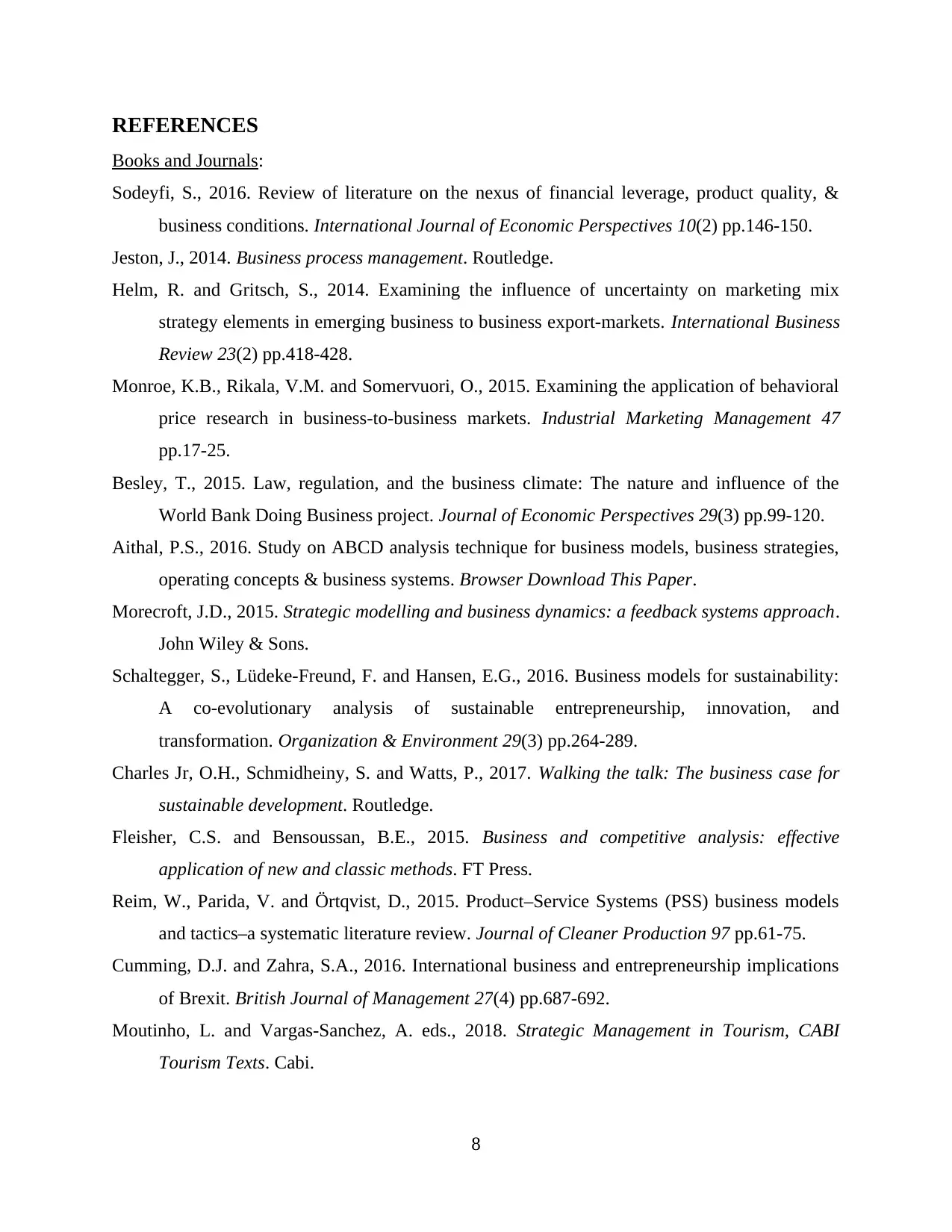
REFERENCES
Books and Journals:
Sodeyfi, S., 2016. Review of literature on the nexus of financial leverage, product quality, &
business conditions. International Journal of Economic Perspectives 10(2) pp.146-150.
Jeston, J., 2014. Business process management. Routledge.
Helm, R. and Gritsch, S., 2014. Examining the influence of uncertainty on marketing mix
strategy elements in emerging business to business export-markets. International Business
Review 23(2) pp.418-428.
Monroe, K.B., Rikala, V.M. and Somervuori, O., 2015. Examining the application of behavioral
price research in business-to-business markets. Industrial Marketing Management 47
pp.17-25.
Besley, T., 2015. Law, regulation, and the business climate: The nature and influence of the
World Bank Doing Business project. Journal of Economic Perspectives 29(3) pp.99-120.
Aithal, P.S., 2016. Study on ABCD analysis technique for business models, business strategies,
operating concepts & business systems. Browser Download This Paper.
Morecroft, J.D., 2015. Strategic modelling and business dynamics: a feedback systems approach.
John Wiley & Sons.
Schaltegger, S., Lüdeke-Freund, F. and Hansen, E.G., 2016. Business models for sustainability:
A co-evolutionary analysis of sustainable entrepreneurship, innovation, and
transformation. Organization & Environment 29(3) pp.264-289.
Charles Jr, O.H., Schmidheiny, S. and Watts, P., 2017. Walking the talk: The business case for
sustainable development. Routledge.
Fleisher, C.S. and Bensoussan, B.E., 2015. Business and competitive analysis: effective
application of new and classic methods. FT Press.
Reim, W., Parida, V. and Örtqvist, D., 2015. Product–Service Systems (PSS) business models
and tactics–a systematic literature review. Journal of Cleaner Production 97 pp.61-75.
Cumming, D.J. and Zahra, S.A., 2016. International business and entrepreneurship implications
of Brexit. British Journal of Management 27(4) pp.687-692.
Moutinho, L. and Vargas-Sanchez, A. eds., 2018. Strategic Management in Tourism, CABI
Tourism Texts. Cabi.
8
Books and Journals:
Sodeyfi, S., 2016. Review of literature on the nexus of financial leverage, product quality, &
business conditions. International Journal of Economic Perspectives 10(2) pp.146-150.
Jeston, J., 2014. Business process management. Routledge.
Helm, R. and Gritsch, S., 2014. Examining the influence of uncertainty on marketing mix
strategy elements in emerging business to business export-markets. International Business
Review 23(2) pp.418-428.
Monroe, K.B., Rikala, V.M. and Somervuori, O., 2015. Examining the application of behavioral
price research in business-to-business markets. Industrial Marketing Management 47
pp.17-25.
Besley, T., 2015. Law, regulation, and the business climate: The nature and influence of the
World Bank Doing Business project. Journal of Economic Perspectives 29(3) pp.99-120.
Aithal, P.S., 2016. Study on ABCD analysis technique for business models, business strategies,
operating concepts & business systems. Browser Download This Paper.
Morecroft, J.D., 2015. Strategic modelling and business dynamics: a feedback systems approach.
John Wiley & Sons.
Schaltegger, S., Lüdeke-Freund, F. and Hansen, E.G., 2016. Business models for sustainability:
A co-evolutionary analysis of sustainable entrepreneurship, innovation, and
transformation. Organization & Environment 29(3) pp.264-289.
Charles Jr, O.H., Schmidheiny, S. and Watts, P., 2017. Walking the talk: The business case for
sustainable development. Routledge.
Fleisher, C.S. and Bensoussan, B.E., 2015. Business and competitive analysis: effective
application of new and classic methods. FT Press.
Reim, W., Parida, V. and Örtqvist, D., 2015. Product–Service Systems (PSS) business models
and tactics–a systematic literature review. Journal of Cleaner Production 97 pp.61-75.
Cumming, D.J. and Zahra, S.A., 2016. International business and entrepreneurship implications
of Brexit. British Journal of Management 27(4) pp.687-692.
Moutinho, L. and Vargas-Sanchez, A. eds., 2018. Strategic Management in Tourism, CABI
Tourism Texts. Cabi.
8
Paraphrase This Document
Need a fresh take? Get an instant paraphrase of this document with our AI Paraphraser
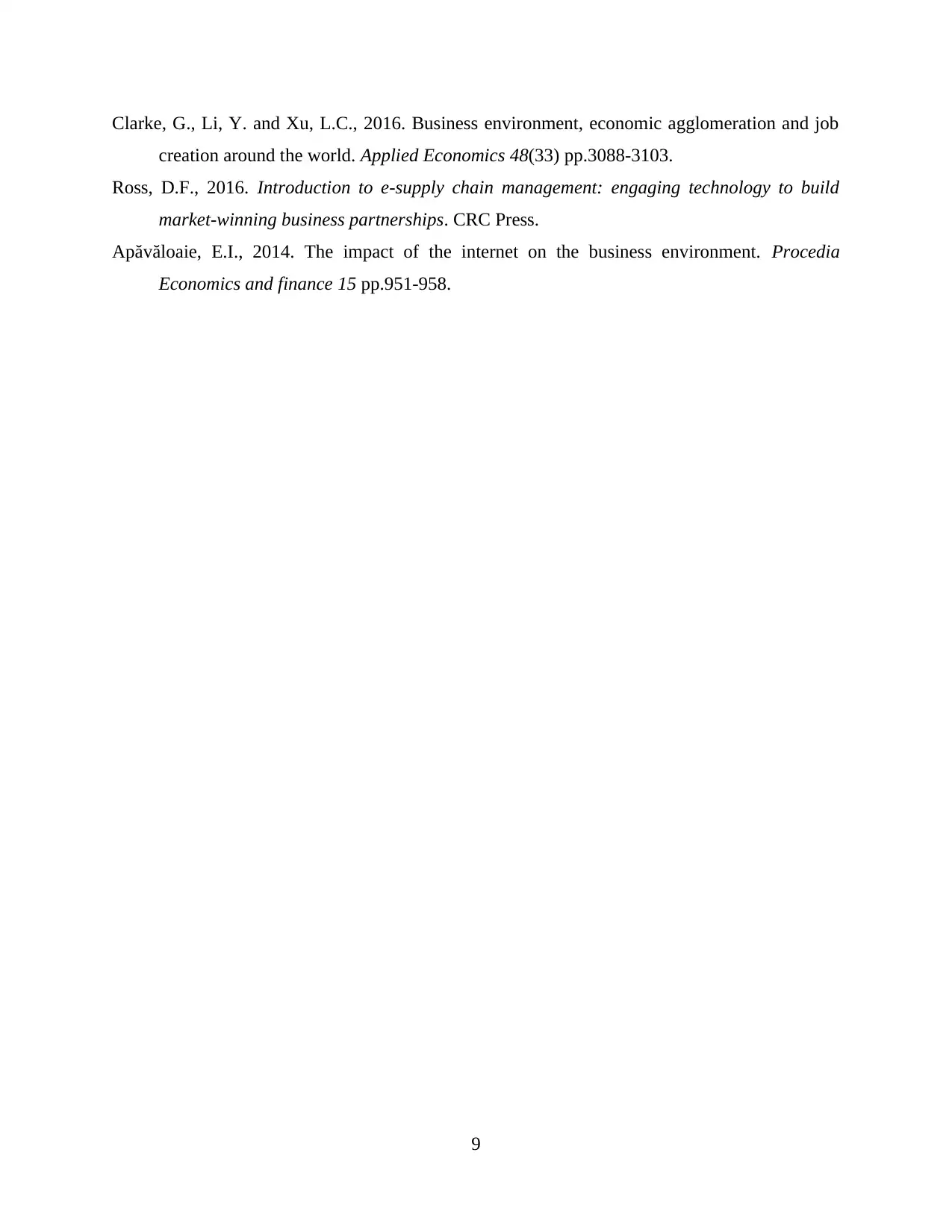
Clarke, G., Li, Y. and Xu, L.C., 2016. Business environment, economic agglomeration and job
creation around the world. Applied Economics 48(33) pp.3088-3103.
Ross, D.F., 2016. Introduction to e-supply chain management: engaging technology to build
market-winning business partnerships. CRC Press.
Apăvăloaie, E.I., 2014. The impact of the internet on the business environment. Procedia
Economics and finance 15 pp.951-958.
9
creation around the world. Applied Economics 48(33) pp.3088-3103.
Ross, D.F., 2016. Introduction to e-supply chain management: engaging technology to build
market-winning business partnerships. CRC Press.
Apăvăloaie, E.I., 2014. The impact of the internet on the business environment. Procedia
Economics and finance 15 pp.951-958.
9
1 out of 11
Related Documents
Your All-in-One AI-Powered Toolkit for Academic Success.
+13062052269
info@desklib.com
Available 24*7 on WhatsApp / Email
![[object Object]](/_next/static/media/star-bottom.7253800d.svg)
Unlock your academic potential
Copyright © 2020–2025 A2Z Services. All Rights Reserved. Developed and managed by ZUCOL.





